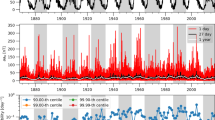Abstract
The results from a statistical analysis of solar wind data obtained near the Earth’s orbit by the DSCOVR spacecraft for the period of one year starting August 2016 are discussed. The distribution of the solar wind temperature T for this period was bimodal and exhibited two maxima at 15 × 103 and 190 × 103 K (with a standard deviation of the same order of magnitude, respectively). This distribution can be represented as the sum of two lognormal distributions. The first peak of the T distribution is caused by the slow-cold wind component, the distributions of which over speed V and density n (varying in wide ranges) are also close to lognormal. This component covers slightly more than a quarter of the entire time period. A fast hot wind (the distribution maximum is at 310 × 103 K) can be distinguished from the remainder; this component covers slightly less than a quarter of the period. Its T, V, and n distributions are also close to lognormal. The rest the wind, nearly half, exhibits a complex “jagged” distribution over speed and a double-peak distribution over density. The conclusion is that data averaging is of key importance in the classification of solar wind at the quantitative level. This is shown by the results of data averaging over a minute, hour, day, and week.








Similar content being viewed by others
REFERENCES
Biesecker, D. and Johnson, J., DSCOVR—Status update and comparing data from L1, in Space Weather Workshop, April 16–20, 2018, Westminster, Colorado, USA, 2018. https://cpaess.ucar.edu/sites/default/files/documents/ sww-2018-presentations/Biesecker_Doug_03.pdf.
Burlaga, L.F. and Lazarus, A.J., Lognormal distributions and spectra of solar wind plasma fluctuations: Wind 1995–1998, J. Geophys. Res., 2000, vol. 105, no. A2, pp. 2357–2364.
Burlaga, L.F. and Szabo, A., Fast and slow flows in the solar wind near the ecliptic at 1 AU?, Space Sci. Rev., 1999, vol. 87, nos. 1–2, pp. 137–140.
de Toma, G., Evolution of coronal holes and implications for high-speed solar wind during the minimum between cycles 23 and 24, Sol. Phys., 2011, vol. 274, pp. 195–217.
Dmitriev, A.V., Suvorova, A.V., and Veselovsky, I.S., Statistical characteristics of the heliospheric plasma and magnetic field at the Earth’s orbit during four solar cycles 20–23, in Handbook on Solar Wind: Effects, Dynamics and Interactions, Johannson, H.E., Ed., New York: Nova Science, 2009. https://arxiv.org/pdf/ 1301.2929v1.
Farrugia, C.J., Harris, B., Leitner, M., et al., Deep solar activity minimum 2007–2009: Solar wind properties and major effects on the terrestrial magnetosphere, Sol. Phys., 2012, vol. 281, pp. 461–489.
Freeman, J.W. and Lopez, R.E., The cold solar wind, J. Geophys. Res., 1985, vol. 90, no. A10, pp. 9885–9887.
Mandel’, I.D., Klasternyi analiz (Cluster Analysis), Moscow: Finansy i statistika, 1988.
NOAA Space Weather Prediction Center (2016): Deep Space Climate Observatory (DSCOVR). NOAA National Centers for Environmental Information. Dataset.https://doi.org/10.7289/V51Z42F7
Veselovsky, I.S., Dmitriev, A.V., and Suvorova, A.V., Algebra and statistics of the solar wind, Cosmic Res., 2010, vol. 48, no. 2, pp. 113–128.
ACKNOWLEDGMENTS
The authors are grateful to M.S. Blokhina for her help with manuscript preparation and to the reviewer for useful comments.
Funding
The work by I.S.V. was supported in part by the Russian Science Foundation (grant no. 16-12-10062).
Author information
Authors and Affiliations
Corresponding authors
Additional information
Translated by E. Petrova
Rights and permissions
About this article
Cite this article
Veselovsky, I.S., Kaportseva, K.B. Role of Averaging in Statistical Analysis of Solar Wind Data from the DSCOVR Spacecraft for the First Year of Operation. Geomagn. Aeron. 59, 257–264 (2019). https://doi.org/10.1134/S0016793219030149
Received:
Revised:
Accepted:
Published:
Issue Date:
DOI: https://doi.org/10.1134/S0016793219030149




